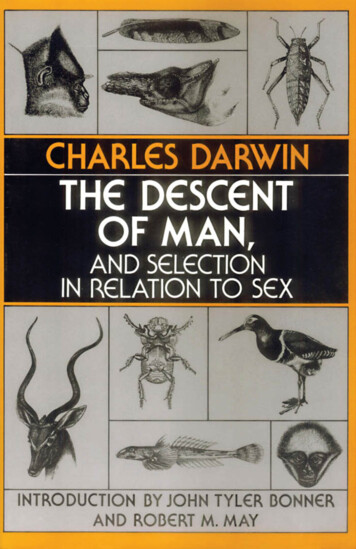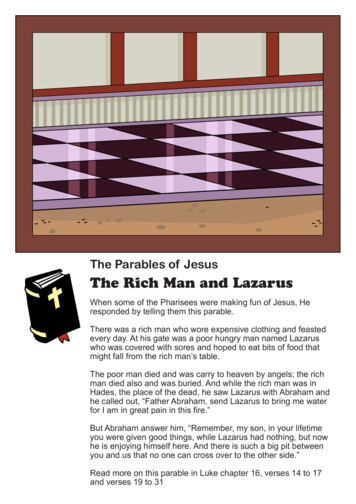
Transcription
THE DESCENT OF M A N ,ANDSELECTION IN RELATION TO SEX
This page intentionally left blank
THE DESCENT OF MAN,AND SELECTION INRELATIONTO SEXby Charles DarwinWith an Introduction byJohn Tyler Bonner and Robert M. MayPRINCETON UNIVERSITY PRESSPRINCETON, NEW JERSEY
Introduction copyright 1981 by Princeton University PressPublished by Princeton University Press,Princeton, New JerseyIn the United Kingdom: Princeton University Press,Chichester, West SussexAll Rights ReservedL IBRARYOFC ONGRESS C ATALOGING-IN- P UBLICATION D ATADarwin, Charles Robert, 1809-1882.The descent of man, and selection in relation to sex.Includes index.1. Evolution.2. Sexual selection in animals.3. Sexual dimorphism (Animals)4. Sex differences.5. Man—Origin.I. Title.QH365.D2 198157580-8679ISBN 0-691-08278-2Photoreproduction of the 1871 edition publishedby J. Murray, LondonThis facsimile is made from the copy of the 1871 edition inFirestone Library, Princeton Universityhttp://pup.princeton.eduDisclaimer:Some images in the original version of this book are notavailable for inclusion in the eBook.
CONTENTSIntroductionBy John Tyler Bonner and Robert M. MayviiA Note on the TextxxxivThe Descent of Man,and Selection in Relation to SexVOLUME IIntroductionP ART I. O N1THED ESCENTOFM ANI. The Evidence of the Descent of Man fromSome Lower FormII. Comparison of the Mental Powers of Man andthe Lower AnimalsIII. Comparison of the Mental Powers of Man andthe Lower Animals, continuedIV. On the Manner of Development of Man fromSome Lower FormV. On the Development of the Intellectual andMoral Faculties during Primeval and CivilisedTimesVI. On the Affinities and Genealogy of ManVII. On the Races of Man93470107158185214P ART II. S EXUAL S ELECTIONVIII. Principles of Sexual SelectionIX. Secondary Sexual Characters in the LowerClasses of the Animal KingdomX. Secondary Sexual Characters of InsectsXI. Insects, continued. Order Lepidoptera253321341386
viCONTENTSVOLUME IIP ART II. S EXUAL S ELECTION, continuedXII. Secondary Sexual Characters of Fishes,Amphibians, and ReptilesXIII. Secondary Sexual Characters of BirdsXIV. Birds, continuedXV. Birds, continuedXVI. Birds, concludedXVII. Secondary Sexual Characters of MammalsXVIII. Secondary Sexual Characters of Mammals,continuedXIX. Secondary Sexual Characters of ManXX. Secondary Sexual Characters of Man,continuedXXI. General Summary and Conclusion13899154183239274316355385Index406Table of Principal Additions and Correctionsto the Edition of 1874Following Index
INTRODUCTIONBy John Tyler Bonner and Robert M. MayTHE REASON for reissuing Charles Darwin's Descent ofMan in 1981, one hundred and ten years after its firstappearance, is that it addresses an extraordinary numberof problems that are, at this moment, on the minds ofmany biologists, psychologists, anthropologists, sociologists, and philosophers. It is the genius of Darwin thathis ideas, clothed as they are in unhurried Victorianprose, are almost as modern now as they were when theywere first published.In this brief introduction, our aims are to indicate theplace the book held in its own time, to point out thoseareas of present-day inquiry where Darwin's commentsand questions are particularly relevant, and to identifywhere his lack of knowledge (particularly in genetics)imposed limitations on his interpretations. The Descent(as we shall henceforth refer to it) is unquestionably second only to the Origin in the Darwinian canon, and theground surveyed here is accordingly covered in muchgreater depth in other works: Gruber and Barrett havegiven a careful analysis of the development of Darwin'sideas on this subject, especially as reflected in the socalled M and N notebooks; Ghiselin's The Triumph ofthe Darwinian Method is an insightful account of Darwin's general method of working, with Chapter 9 particularly relevant to the Descent; and the collection ofessays on Sexual Selection and the Descent of Man, edited by Campbell, is also helpful.1** Notes are given at the end of the Introduction.
viiiINTRODUCTIONA separate Note on the Text at the end of this introduction explains why the first rather than the secondedition was chosen for reprinting, and why it was notabridged. We also suggest a way of skipping through thebook—a de facto abridgment—which will enable areader to encounter most of the basic thoughts and questions, bypassing many of the catalogues of examples.T HE B OOKIN ITSO WN T IMECONTENT OF The DescentThe structure of the Descent of Man, and Selectionin Relation to Sex is unusual in that, as the title clearlystates, it consists of two vast subjects which are cementedtogether at the end by a discussion of the role of sexualselection in man. The major theme of the first part ofthe work is simply that man descended from other animals and was not specially created. The book, however,does more than marshal the evidence for the continuitybetween man and other animals (with all the philosophical materialism thus implied). As observed by Gruber,it also represents Darwin's attempt to "study intelligenceas a central feature of adaptive change, and to study itin that organism in which it is most prominent, man."2The theme of the second part of the book is that besidesnatural selection there is sexual selection, so that notonly will the general character of a species change overtime, but the character of the two sexes may also change,as in, for instance, the peacock and the peahen.Neither part of the Descent can be understood withoutreference back to the Origin, whose three-strandedthread of argument runs as follows. First, there is variation among the individuals in populations of plants andanimals, both natural and domesticated, and some of this
INTRODUCTIONixvariation is heritable. Second, organisms in nature tendto produce more offspring than can survive to reproductive age if the population is to remain, on average,steady over any length of time. There is thus a "strugglefor existence," in which individuals with certain variations may be favored (or "naturally selected"); these favored individuals will tend to spawn children and grandchildren possessing their traits, their variations. Third,it can happen that over the span of geological time newspecies eventually evolve by such processes of naturalselection. Darwin saw sexual selection as an importantvariation upon the theme of natural selection, with certain traits in the male (or, less commonly, the female)making him (or her) more successful in mating; the resultis a dimorphism between the sexes. Darwin shows thatthese two kinds of selection can act in concert, or not,and if the latter, then the structure of the sexes reachessome sort of compromise between the pulls of naturaland sexual selection.As we shall discuss further below, one of Darwin'sgreatest problems was to understand how variationsarise, how variability is maintained, and how and to whatextent variations are inherited. Without an understanding of genetics this enterprise was doomed. Not the leastof Darwin's strengths was the courage and the senseeventually to base his theory on the observed—butunexplained—fact that variability existed. However, in1838 when he began the M and N notebooks, upon whichmuch of the Descent is based, he still hoped to discoverthe basis of variability and heritability; ideas and information about man's intellect looked like a promising testing ground for exploring hypotheses about heritable variation. Hence the discussions of South American natives,and particularly of the three Tierra del Fuegans transported into English society.
xINTRODUCTIOND E V E L O P M E N T O F I D E A S I N The DescentWorking from the notebooks3 Darwin kept in the years1837-1839—the B, C, D, and E notebooks dealing withevolution in general, and the M and N notebooks with"Man, Mind and Materialism"—Gruber and others haveshown that Darwin's thinking about man was, from thestart, an integral part of his exploration of evolutionaryquestions: "the subject of man and his place in naturewas so woven into Darwin's thoughts that it forms anindispensable part of the network of his beliefs."4 Specifically, the first passage in the M and N notebookswhich clearly enunciates the principle of natural selection and applies it to man appears in the N book around27 November 1838.5 An earlier passage in the more general C notebook says, "I will never allow that becausethere is a chasm between man . . . and animals that manhas a different origin."6 And the M notebook of 16 August1838 contains a triumphal passage with all the combativering of contemporary sociobiology: "He who understandsbaboon would do more toward metaphysics than Locke."7In short, although Darwin in his public utterances wasfor a long time reticent concerning his opinion aboutman, his private thoughts are clear. The basic intellectualedifice presented in the Origin and in the Descent wasin place by 1838, and his subsequent actions may be seenas a "strategy involving two grand detours: the first, along delay before publishing his general theory of evolution, and the second, another long delay before revealing his ideas on the evolution of man."8 The reasonsfor the first of Darwin's long delays, until Wallace's independent enunciation of the principle of natural selection precipitated the publication of the Origin in 1859,have been much discussed. The Origin does have a chapter entitled "Instincts," which deals with some psycho-
INTRODUCTIONxilogical issues, but the book avoids discussion of highermental processes, and (as Darwin admits on the first pageof the Descent) refers to man only through the evasivephrase that "light will be thrown on the origin of manand his history."The idea that evolution by natural selection could account for the origin of man was taken up by others as adirect result of Darwin's ideas. The respected T. H.Huxley did this explicitly in 1863 in his Evidence as toMan's Place in Nature. So did the flamboyant Germanbiologist Haeckel, who even invented an imaginary missing link between ape and man, Pithecanthropus alalus,the speechless apeman. One of the principal dissentingvoices was that of Alfred Wallace, who published an essayin 1864 saying that the bodily structure of man could beentirely accounted for on the basis of natural selection,but that the mind of man was created by some "higherintelligence."9 As a result, Darwin could hardly haveexpected that his book would create any surprises;rather, he must have wanted to present in detail his ownposition and publish the great mass of evidence he hadaccumulated. By 1871 he was a famous person; everyonewas eager to know what he had to say of this subject, socentral at the time.A convincing explanation for Darwin's two long hesitations is that he had a lively apprehension of the troublehe was inviting. The Origin, doing away with the needfor Creation, was bad enough; but (as Wallace and manyothers showed) its message could be reconciled with abasically religious view of man's place in the world. Thefrank out-and-out materialism of the Descent was worse,leaving no role for the Deity to play. Moreover, asGruber emphasizes, Darwin knew that he ran real risks,more substantial than the simple storms of public controversy.10 As an undergraduate at Edinburgh Univer-
xiiINTRODUCTIONsity, he had seen a fellow student's paper formally expunged from the records of the Plinian Society becauseit argued that "mind is material." Earlier, in 1819, adistinguished surgeon, Lawrence, had published his Lectures on Physiology, Zoology, and the Natural Historyof Man; this work was decried as expounding materialism, and Lawrence withdrew the book and resigned hispost as lecturer. When a pirate edition was publishedin 1822, he lost a suit against the publisher, under a lawdating back to the Star Chamber of Charles I wherebyan author had no property rights to a "blasphemous,seditious, or immoral" work. Darwin refers to this bookin the Descent.The fact that the basic ideas in the Descent are contained in the M and N notebooks of 1838 does not implythat fears of fierce controversy alone detained Darwinfrom producing the book then. Much hard work remained to be done, collecting facts and observations tobind to the framework and testify to its soundness. Thiswork, a lot of which was very original, was done around1867-1871. The project was initially conceived as havingthree parts, of which the first two (the descent of manand selection in relation to sex) were realized, while thethird (the expression of the emotions in man and animals)grew into a separate and important work, published in1872.11DARWIN'S SCIENTIFIC METHODIn this general context, it is interesting to look at theway Darwin went about his work. Gruber gives a particularly fascinating discussion of the disparity betweenwhat Darwin actually did, and what he said he did. Inhis books, Darwin consistently portrays himself as cleaving to the accepted Baconian canons: first marshal thefacts, then see what conclusions emerge. Thus on page
INTRODUCTIONxiiione of the Origin, he claims to have "patiently accumulat[ed]and reflect[ed] on all sorts of facts which could possiblyhave any bearing on it. After five years' work I allowedmyself to speculate on the subject, and drew up someshort notes. . . . " Likewise, on page one of The Expression of the Emotions in Man and Animals, he explainsthat "I arrived, however, at these three Principles onlyat the close of my observations." The actuality of the B,C, D, E, M, and N notebooks tells a very different story,and one which is more familiar to a practicing scientist.Gruber summarizes this beautifully: "The pandemoniumof Darwin's notebooks and his actual way of working, inwhich many different processes tumble over each otherin untidy sequences—theorizing, experimenting, casualobserving, cagey questioning, reading, etc.—would neverhave passed muster in a methodological court of inquiry. . . He gave his work the time and energy necessary topermit this confusion to arise, at the same time persistently sorting it out, finding what order he could. It wasan essential part of this 'method' that he worked at alltimes within the framework of a point of view which gavemeaning and coherence to seemingly unrelated facts."12In addition to the evidence implicit in the notebooks,Darwin's correspondence shows the divergence betweenprivate views and public pieties: "all observation mustbe for or against some view if it is to be of any service!";"let theory guide your observations, but till your reputation is well established be sparing in publishing theory.It makes persons doubt your observations."13Naively simple formulations of The Way to do science—be they Baconian, Popperian, or otherwise—are,if anything, more pervasive today than they were inDarwin's time. We believe that Darwin got it right whenhe wrote, "The only advantage of discovering laws is toforetell what will happen and to see bearing of scattered
xivINTRODUCTIONfacts,"14 and that the scrabbling, nonlinear way he pursued this end is typical of most good science. As Ghiselinputs it: "Viewed from without, science appears to be abody of answers; from within, it is a way of asking questions. . . . The 'predictionist thesis' and 'hypotheticodeductive' model seem a bit trivial as clues to what realscientists are trying to do."15 This struggle toward understanding and "seeing the bearing of scattered facts"is not entirely concealed in the finished products, andthe Descent is interesting for the persistent questionsthat underlie the structure of the book.A criticism often leveled against the theory of evolutionby natural selection is that it is little more than a collection of Just So Stories, in which particular facets ofbehavior or morphology are argued to be "adaptive" or"optimally designed" to fulfill purposes which are tautologically inferred from the behavioral or morphologicalfeature in question.16 It is true that individual pieces ofthe evolutionary puzzle, taken one by one without replicates, controls, or comparisons, are indeed each susceptible to one or more ad hoc anecdotal explanations.These are the general grounds for Popper's suggestionthat evolut onary thinking is metaphysical, and inherently unfalsifiable.17 Darwin, however, had a fully modern awareness both of this methodological problem andof one answer to it. By deliberately collecting comparative information for large assemblies of different organisms (geographical races, species, or other taxonomicgroupings), he showed that it is possible to documentbroad trends and patterns among behavior, morphology,or biogeographical features. Moreover, these patternsin such phenomena as geographical distribution or vestigial organs can often be correlated with systematic patterns in the differing environmental circumstances of theorganisms under study.
INTRODUCTIONxvSuch comparative studies can then permit predictionsto be made about as yet unstudied species. Some instances are given below. For example, the relationshipbetween the degree of sexual dimorphism and the socioeconomic sex ratio (females per reproductive male)recently obtained by Clutton-Brock, Harvey, and Rudder for primate species would enable a rough predictionto be made about either one of these quantities once theother is determined for a species not included in theoriginal study.18 Whatever their philosophical status,these methods are capable of generating testable predictions that are not qualitatively different from those ofthe physical sciences. The extreme assertion that evolutionary biology can never aspire to more than "thickdescription" of individual cases, each unique (as advocated on similar grounds in a different context by somesocial scientists),19 fails to comprehend the power of thecomparative methods employed by Darwin and refinedby later workers.In one important way, however, many predictions inthe biological sciences do differ from those we are familiarwith in classical physics. In physics and engineering,most simple predictions or tests of hypotheses are crisplyand pleasingly deterministic. But in population biology,ecology, and evolutionary biology, many of the predictions are inherently probabilistic (as, for similar reasons,are the predictions of meteorology or portfolio theory).This point is emphasized by Gruber and Barrett, Monod,20and others, and it has implications that range from thegrand sweep of evolutionary thinking to important practical aspects of fisheries management.21DARWIN'S STYLE OF PRESENTATIONFinally, it is worth commenting on Darwin's style ofpresentation. The language is simple and vivid, and to
xviINTRODUCTIONa reader accustomed to the elaborately "objective" circumlocutions of much of the contemporary social sciences it may appear alarmingly anthropomorphic andteleological. Ghiselin analyzes this issue in detail, showing clearly that there is a world of difference betweenDarwin's "metaphorical use of anthropomorphic expressions and the propositions which he actually asserts." AsGhiselin demonstrates, Darwin "used everyday terminology to convey precise and definite meanings, withelegance and clarity. For instance, Darwin gives twopictures in which he shows the contrasting appearanceof cats under conditions involving precisely oppositekinds of behavior. These are entitled 'Cat, Savage, andPrepared to Fight . . .' and 'Cat in an Affectionate Frameof Mind. . . .' Contemporary biologists may regard thesecaptions with amusement, even delight, for the prevailing standards of pedantry are opposed to such expressions, even though nobody ever would take them literally, and even though they could scarcely better expressthe underlying ideas."22 Darwin preferred playing withdogs to engaging in ludic activity with canine companions.Probably the most striking stylistic difference betweenthe book Darwin wrote in 1871 and the one he wouldwrite if he lived today lies in his discussion of the racesof man and the differences between the human sexes.For his period he is remarkably objective on the matterof race, although he does make it clear that to be civilizedmeans to be like an educated Englishman. Here he waspartly influenced by his voyage on the HMS Beagle asa young man, where the unspeakable behavior of theTierra del Fuego Indians impressed him enormously.They had no religion, no care of their hair or their rudeclothing, no obvious code of morals, and they ate theirgrandmothers first when food was short. Yet he sees that
INTRODUCTIONxviithose natives who were taken to be educated for a periodin England did appear to become civilized; they werecapable of improvement. Darwin had the capacity to seebeyond the prejudices and ideologies of his own timeand culture—more so, indeed, than many who work inthese general areas today.Those readers who are sensitive to sexism may beprovoked to considerable outrage by Darwin's short discussion of "the difference in the mental powers of thetwo sexes." Here he is reflecting no more than the common view of the time, and this unreflective attitude issomewhat mitigated by a curious and somewhat obscurepassage on page 329 where he seems to imply thatwomen could become like men in their mental facilitiesif they were provided with suitable opportunities andtraining. (It may be remarked that his diligently keptrecord of backgammon games with his wife show themroughly evenly matched, with Darwin at one time aheadby 2,795 to 2,490.23 Did he not realize the highly analytical character of this game? Most likely, he neverthought about it.)S OME S CIENTIFIC P ROBLEMS C ONFRONTINGD ARWIN'S W ORK IN THE N INETEENTH C ENTURYDiscussion of the public reception of Darwin's worktends to center around the religious and other broadlyphilosophical issues. It is often not fully appreciated thatthe theory of natural selection met with very seriousscientific objections.Without a precise understanding of genetics and thelaws of Mendelian inheritance, the causes and heritability of variation among individuals in natural and domesticated populations are bound to be a bit mysterious.
xviiiINTRODUCTIONAround 1838, Darwin still hoped to solve this mysteryand place his theory on a solid base. As we have seen,the M and N notebooks from which the Descent sprangwere begun partly in the hope of using man's origins toshed light on the sources and mechanisms of heritablevariation, and to test hypotheses about habits becominghereditary. In retreating to the position of taking heritable variation to be an unexplained premise, Darwinwas condemned to a lifelong struggle with two largeproblems which he never satisfactorily resolved.The first problem stemmed from the received wisdomof Darwin's time, namely, that inheritance worked bya blending of maternal and paternal characters. As emphasized to Darwin by Fleeming Jenkin,24 under blending inheritance variation simply cannot be maintained!The essentials of the argument can be grasped by considering a trait (such as height or weight) that can bedescribed by a single variable.25 Suppose the motherdeparts from the population average in this respect byan amount x, and the father by an amount y. Then, undera scheme of blending inheritance, the progeny will depart from the mean by ½(x y). In the parental generation, suppose the statistical scatter of the variableabout its mean value is characterized by a variance σ2;that is, the expectation values of x2 and y2 are both σ 2( x2 y2 σ2). In the next generation, thecorresponding variance is the expectation value of (¼)(x y)2 or (¼) ( x2 y2 2 xy ), which is equalto ½σ2 (1 ρ). Here ρ is the correlation coefficientbetween x and y. If mating is at random, ρ 0, and thevariance of the trait among the offspring is ½σ 2; thevariance is halved in a single generation. Even if thereis a tendency for like to seek like in mating, so that ρ 0, the variance will still decrease in each generation(except in the unlikely extreme of perfectly sorted mat-
INTRODUCTIONxixing, with ρ 1). In short, the mid-nineteenth-centuryconventional wisdom of blending inheritance was flatlyinconsistent with the observed propensity for naturalpopulations to exhibit variability. Darwin was troubledby this inconsistency. The answer, of course, lies in thefact that genes are inherited in particulate Mendelianfashion, not by "blending." The basic theorem of Mendelian population genetics—the Hardy-Weinberg theorem, proved in 1908—can be rephrased to state that, inthe absence of perturbing factors (such as mutation, selection, drift, migration, or nonrandom mating), varianceremains constant from generation to generation.Mendel's paper on the laws of heredity, providing thekey to the puzzle, was published five years before theDescent appeared.26 Although in German, the paper wasnot in an obscure journal, and was accessible to Darwinand his colleagues. Fisher has made the interesting andplausible suggestion that Mendel's work was overlookedbecause it was cast in a mathematical idiom, which wastruly a foreign language to nineteenth-century Britishnaturalists. De Beer notes Darwin's regret for his ignorance of mathematics;27 if Fisher's explanation is correct, Darwin had more to regret than he realized! Itremained for the early twentieth century to rediscoverMendel.28The second problem associated with Darwin's lack ofbasic understanding of genetics is that he did not fullycomprehend the distinction between what we would callgene inheritance and the inheritance of habits, customs,and behavior. In the Descent and elsewhere, Darwinrepeatedly says that if an animal behaves in a particularway for a number of generations, this will result in thebehavior becoming permanently fixed. Today we knowthere are some sorts of behaviors that do become genetically fixed, but we understand that the mutations
xxINTRODUCTIONwhich produce these changes have nothing to do withtransmitting the information by teaching and learning.There is a vast difference between behavioral transmission and genetic transmission of information.In addition to the central difficulty of dealing withvariation and heritability in the absence of Mendeliangenetics, Darwin had other technical problems when heturned to sexual selection.29 In general, discussions ofsexual selection involve the concepts of sex-linked genesand the role of hormones in producing secondary sexualcharacteristics. These concepts, whose implications arepursued further below, were not available in Darwin'stime.Another, and quite different, class of difficulties arosebecause the only fundamental energy sources known tophysics in Darwin's day were those associated with theelectromagnetic and gravitational forces. Kelvin showedthat if the sun's energy source was gravitational, it couldnot possibly have been burning for more than about 20million years, and that chemical (electromagnetic) fuelswould have given an even shorter life. A different calculation showed that it could not have taken more thanaround 20-40 million years for the earth to cool frommolten rock to its present temperature. These two calculations meant that either the earth was at most a fewtens of millions of years old, or that Victorian physicswas fundamentally deficient. Faced with Kelvin's arguments, Darwin removed all numerical references to geological time spans in the third and later editions of theOrigin,30 and you will look in vain for any explicit chronology in the Descent. The discovery of the weak andstrong nuclear forces has, of course, shown us that Victorian physics was indeed fundamentally deficient insome respects: the sun has burned nuclear fuel for nearlyfive billion years; and the heat generated by decay of
INTRODUCTIONxxiradioactive elements inside the earth invalidated Kelvin'scalculations about cooling rates. Darwin was nearer ourmodern view in his first purely geological calculations;there is enough time to account for the evolution of man.T HE B OOKINR ELATIONTOR ESEARCH T ODAYPART ONE: THE DESCENT OF MANIn Part One of the Descent, Darwin argues from comparative analyses of morphology and behavior that manis basically not different from other animals, and thatwhat differences do exist are simply a matter of degree.His arguments about the bodily structure of man, withthe exception of the brain, were relatively uncontroversial in his own time, and are entirely acceptable today.The real controversy surrounding the relation betweenman and other animals in Darwin's time was essentiallya problem of science versus religion. As we have mentioned, even Wallace wrote an essay saying the morphology of man could be entirely accounted for by naturalselection, but that man's "intellectual and moral faculties. . . must have had another origin . . . in the unseenuniverse of Spirit."31 Except for a disturbing resurgenceof anti-intellectual fundamentalism in North America inrecent years, this idea that the Creation must have supervened somewhere along the evolutionary line leadingto man is no longer the issue. The idea has, however,been replaced by a doctrine held firmly by many socialscientists. They see human culture and civilization asbeing something so special and so unlike anything elsewhere in the animal world that it can only be analyzedin its own terms, and not in terms of the level below(that is, not in terms of biology). The argument is interestingly similar to that of Wallace and other religious
xxiiINTRODUCTIONpeople in the nineteenth century: the body of man isindeed a biological structure, clearly descended from theapes, but his culture, which stems from his extraordinaryand unique mind, is on a new, higher hierarchical levelof its own; evolutionary biology has nothing to tell usabout this higher level. This resistance to exploring thepossibility that principles of evolutionary biology canshed light on human societies is most recently demonstrated in the reaction32 of some sociologists, anthropologists
The theme of the second part of the book is that besides natural selection there is sexual selection, so that not only will the general character of a species change over time, but the character of the two sexes may also change, as in, for instance, the peacock and the peahen. Neither part of the Descent can be understood without










